
The dachshund, also known as the wiener dog, badger dog, or sausage dog, is a short-legged, long-bodied, hound-type dog breed. They may be smooth, wire, or long-haired.
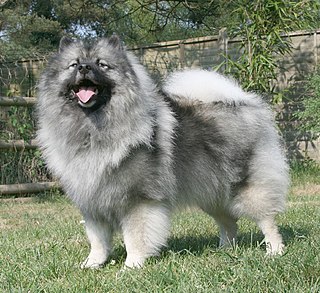
The Keeshond is a medium-sized dog with a plush, two-layer coat of silver and black fur with a ruff and a curled tail. It originated in Holland, and its closest relatives are the German spitzes such as the Großspitz, Mittelspitz, Kleinspitz, Zwergspitz (Dwarf-Spitz) or Pomeranian.

The Shiba Inu is a Japanese breed of hunting dog. A small-to-medium breed, it is the smallest of the six original and distinct spitz breeds of dog native to Japan.

The Catahoula Leopard Dog is an American dog breed named after Catahoula Parish, Louisiana. It became the state dog of Louisiana in 1979. It is recognized by the United Kennel Club (UKC) under the name Louisiana Catahoula Leopard Dog, and Catahoula Leopard Dog in the American Kennel Club (AKC) Foundation Stock Service. Both registries have assigned the breed a herding group designation. It has traditionally been used in hunting feral boars.

The American Eskimo Dog is a breed of companion dog, originating in Germany. The American Eskimo Dog is a member of the Spitz family. The breed's progenitors were German Spitz, but due to anti-German sentiment during the First World War, it was renamed "American Eskimo Dog." Although modern American Eskimo Dogs have been exported as German Spitz Gross, the breeds have diverged and the standards are significantly different. In addition to serving as a watchdog and companion, the American Eskimo Dog also achieved a high degree of popularity in the United States in the 1930s and 1940s as a circus performer.

The Shetland Sheepdog, often known as the Sheltie, is a breed of herding dog that originated in the Shetland Islands of Scotland. The original name was Shetland Collie, but this caused controversy among the Rough Collie breeders of the time, so the breed's name was formally changed. This hard-working small dog is intelligent, vocal, excitable and willing to please. They are incredibly loyal to their owners to the point where they are often referred to as "shadows" due to their attachment to family. This breed was formally recognized by The Kennel Club (UK) in 1909.

A Schipperke is a small Belgian breed of dog that originated in the early 16th century. There has been a long informal debate over whether this type of dog is a spitz or miniature sheepdog. In their home country of Belgium they are considered a small shepherd.

The Cavalier King Charles Spaniel is a small breed of spaniel classed in the toy group of The Kennel Club and the American Kennel Club, that originated in the United Kingdom. Since 2000, it has grown in popularity in the United States and ranks as the 19th most popular pure-breed in the United States. It has a silky, smooth coat and commonly a smooth undocked tail. The breed standard recognizes four colors: Blenheim, tricolor (black/white/tan), black and tan, and ruby. The breed is generally friendly, affectionate, and good with both children and other animals; however, they require much human interaction. Since they are family dogs, it is recommended to not leave one alone for long periods at a time. The expected average lifespan of a Cavalier King Charles Spaniel is between nine and fourteen years.
The Yorkshire Terrier is one of the smallest dog breed of terrier type, and of any dog breed. The breed developed during the 19th century in Yorkshire, England. Ideally its maximum size is 7 pounds (3.2 kg). A popular companion dog, the Yorkshire Terrier has also been part of the development of other breeds, such as the Silky Terrier. It has a grey, black and tan coat, and the breed's nickname is Yorkie.

The Poodle is a dog breed that comes in three varieties: Standard Poodle, Miniature Poodle, and Toy Poodle. The origin of the breed is still discussed, with a prominent dispute over whether the poodle descends from Germany as a type of water dog, or from the French Barbet.

The French Bulldog is a breed of domestic dog, bred to be companion dogs. The breed is the result of a cross between Toy Bulldogs imported from England and local ratters in Paris, France, in the 1800s. They are stocky, compact dogs with a friendly, mild-mannered temperament.

The Norwich Terrier is a breed of dog originating in the United Kingdom, and was bred to hunt small rodents. With a friendly personality, Norwich Terriers are today mostly a companion dog breed. One of the smallest terriers, these dogs are generally healthy, but are relatively rare, due in part to their low litter size and the common need for caesarian sections. Their drop-eared variety is the Norfolk Terrier. Recognized as the "official breed of England" in 1932, Norwich Terriers have been delighting owners around the world as a hardworking, loyal companion dogs for nearly a century.

Havanese is the national dog of Cuba, developed from the now extinct Blanquito de la Habana. The Blanquito descended from the also now-extinct Bichón Tenerife. It is believed that the Blanquito was eventually cross-bred with other bichon types, including the poodle, to create what is now known as the Havanese. Sometimes referred to as "Havana Silk Dogs", this was originally another name for the Blanquito de la Habana.
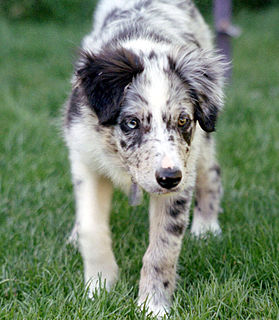
Merle is a genetic pattern that can be in a dog's coat. Merle comes in different colors and patterns and can affect all coat colors. The merle gene creates mottled patches of color in a solid or piebald coat, blue or odd-colored eyes, and can affect skin pigment as well. There are two general types of colored patches that will appear in a merle coat: liver and black. Some breeds that can be affected by this genetic trait are Australian Shepherds and Catahoula Leopard Dogs. This genetic trait should be taken seriously when breeding merles. Health issues are more typical and more severe when two merles are bred together, so it is recommended that a merle be bred with a non-merle dog of any other color.
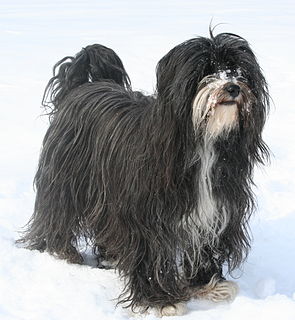
The Tibetan Terrier is a medium-size breed of dog that originated in Tibet. Despite its name, it is not a member of the terrier group. The breed was given its English name by European travelers due to its resemblance to known terrier breeds. The Tibetan name for the breed, Tsang Apso, roughly translates to "shaggy or bearded ("apso") dog, from the province of Tsang". Some old travelers' accounts refer to the dog as Dokhi Apso or "outdoor" Apso, indicating a shaggy or bearded working dog which lives outdoors.

The Löwchen or Little Lion Dog is a breed of small dog. The Löwchen once had the dubious distinction, like the Portuguese Water Dog and the Havanese, of being the rarest dog in the world. In 1973 there were only 65 registered examples of the breed. Even today, the breed generally has fewer than a few hundred new registrations each year worldwide.

The Pumi is a medium-small breed of sheep dog from Hungary. They are versatile stock dogs equally adept at gathering, driving and keeping stock under control. They have a long head with semi-erect ears, a whimsical expression, and a tail that forms a circle over the back. The coat is a combination of wavy and curly hair forming curls all over the body.

The Eurasier, or Eurasian dog, is a breed of dog of the spitz type that originated in Germany. It is widely known as a wonderful companion that maintains its own personality, has a dignified reserve to strangers, a strong bond to its family and that is relatively easy to train.

The Russian Toy is a very small breed of dog originally bred in Russia from the English Toy Terrier. There are two types of coats in the breed: smooth coat and long coat. The smooth-coated variety was previously known as the Russian Toy Terrier and long-coated as the Moscow Long-Haired Toy Terrier. Both were brought together under the same Russian Toy Terrier name in 1988 and the "Terrier" was dropped from the name when the breed was added in 2006 to the official list of breeds registered with the Fédération Cynologique Internationale and has been registered in the Foundation Stock Service of the American Kennel Club since 2008, allowed to compete in AKC companion events since 2010. The first official breed standard of the two varieties was written in 1966 in Russia.

The Chihuahua is the smallest breed of dog, and is named after the Mexican state of Chihuahua.


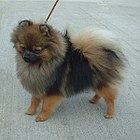

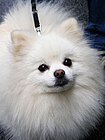


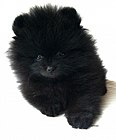
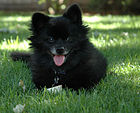

![A Toy Spaniel, a Dwarf Spitz and a Maltese next to a basket (1855) by Johann Friedrich Wilhelm Wegener [de]. Wegener01.jpeg](http://upload.wikimedia.org/wikipedia/commons/thumb/7/7a/Wegener01.jpeg/330px-Wegener01.jpeg)




















